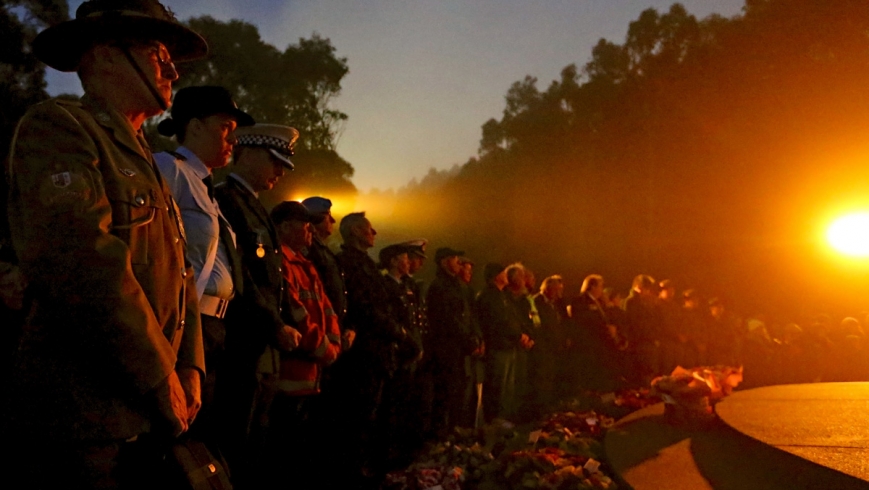As Australians prepare to mark the centenary of the Anzacs landing at Gallipoli, Matt Crossman digs through the history pages and sheds lights on the Diggers from the west who were part of the action and some who never returned
One-hundred years ago, our soldiers went with songs to battle.
As Laurence Binyon would later write in his famous poem For The Fallen, they were young, straight of limb, true of eye, steady and aglow.
Military records show more than 100,000 Victorians enlisted for World War I.
Many thousands from Melbourne’s north and west were among those who answered the call, heading to Europe, Africa and the Middle East to fight for king and country.
Ahead of the centenary of the Australian and New Zealand Army Corps’ landing at Gallipoli, families and communities with links to the first Anzacs are preparing to again honour the sacrifice of their forebears.
Broadmeadows played a major supporting role in the Great War effort after the declaration came in August 1914.
A military camp was quickly established on property offered by a local landowner and less than two weeks later about 2500 men marched north from the CBD to the camp at Mornington Park.
Despite being largely made up by tents, and having significant drainage issues that later led to health concerns, the camp churned out many thousands of war-ready soldiers for the Australian Imperial Force.
They included George Henry Sheppard, one of three Footscray brothers who saw service in the war.
George, the eldest, was 28 when he was killed in the Gallipoli landing on April 25, 1915.
A lance corporal in the 7th Battalion, he was initially reported as missing in action and some hoped he might still be alive.
In mid-December 1915, a local newspaper later reported that ‘‘Corporal George H. Sheppard, son of Mr and Mrs H. Sheppard, of 96 Creswick Street … was not killed at Gallipoli but taken prisoner by the Turks and sent to Constantinople.’’
‘‘His many friends will be pleased and glad to hear the good news,’’ the Footscray Independent reported.
Subsequent investigations by the army failed to turn up any such news.
A court of inquiry held in France in September 1917 declared George had been among the many thousands of men killed on the beaches on that first day. His body was never found.
George’s younger brother Bertie, 25, also fought at Gallipoli.
Documents in the national archives show his eyesight was damaged in battle but he later returned to action in France, where he was killed in 1916.
Youngest brother Harry, 19 when he enlisted, fought in France but his military records show he returned home in 1917 ‘‘for family reasons’’.

Gordon Duke Stuart is among the men named on honour boards in Werribee. Sergeant Stuart, a member of the 12th Infantry Battalion, was just 24 years old at the Gallipoli landing.
His battalion was among the first to hit the beaches in the early hours of April 25.
Like George Sheppard, Sergeant Stuart, a coach trimmer by trade, was also reported missing but later found to have been killed.
His body, which wasn’t found until 1923, is buried in Lone Pine cemetery.
Bacchus Marsh’s Charles Edwards landed at Gallipoli a few weeks later.
A member of the 4th Light Horse Regiment, the 22-year-old farmer was among those deployed without their horses to reinforce the infantry.
In a letter penned while on holiday about 15 miles from Gallipoli in July, 1915, he wrote ‘‘we still seem to have the good name we earned’’.
‘‘… you see by the papers how things are going – and see a few good lies printed too, I suppose.
‘‘Six of us are sitting under a fine fig tree writing letters. It is alright to be able to sit down without dodging shrapnel.’’
Shaded by a majestic line of 281 memorial elm trees, Bacchus Marsh’s famous Avenue of Honour pays tribute to the many brave Diggers from the then farming district.
The trees, each bearing a plaque with the name of a local soldier, were planted on the afternoon of August 10, 1918.
More than 1000 people took part in the event, gathering along the length of the 3.2km stretch and planting seedlings after a bugle sounded.
Almost a century later, the elms are a lasting reminder of the hundreds of young locals who so valiantly served their nation.
Men from the Moorabool area were quick to enlist for battle, with the Bacchus Marsh Express of September 5, 1914 reporting that locals such as Charles Waterhouse, Alfred Farrow, Arthur Hine and Webbe Crook were among those farewelled at a meeting held one month after Australia joined Britain in entering the conflict.
Richard Norman Smith was two days short of his 16th birthday when he signed up on November 27, 1914.
Records show the young labourer from Rowsley was discharged, medically unfit, in early 1915 but enlisted in the 24th Battalion, D company on March 25. He landed at Gallipoli in September and spent 16 weeks in the Lone Pine trenches before being shot in the right foot in December that year.
Taken to military hospital in Egypt, he later spent time in France and England, progressing to the rank of sergeant before returning to Australia in 1919.
To the north of Bacchus Marsh, Kyneton was another town that played a significant role in World War I.
The town lays claim as one of the earliest homes of a volunteer military troop, commencing with the Kyneton Mounted Rifle Troop in 1859.
The 4th Light Horse regiment served on three fronts in World War I – at Gallipoli, on the Western Front and in Palestine.
Kyneton Light Horse Monument Group secretary Larina Strauch said a recently unveiled statue of a charging soldier, bayonet in hand, had increased awareness of the town’s place as one of the spiritual homes of the famous brigade.
About 250 men from the Kyneton district enlisted for the war, including Thomas O’Leary, one of the first soldiers killed in the Gallipoli landing.
While 100 years have passed since Gallipoli, Ms Strauch said it was important that people continued to acknowledge the service of countless young soldiers, sailors and nurses.
‘‘It’s not about glorifying conflict. It’s about honouring those who went before us and recognising the horror that was World War I.’’
Binyon’s poem, which includes the ode of remembrance recited at services around the country, observes that allied soldiers were staunch to the end against odds uncounted and concludes:
As the stars that shall be bright when we are dust,
Moving in marches upon the heavenly plain,
As the stars that are starry in the time of our darkness,
To the end, to the end, they remain.







